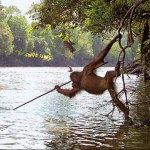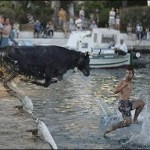Human
by Katie the Lowly Intern
You might recall this gentle soul who got her face gnawed off by a chimp in February. I won't even begin to sift through the big ball of bizarre that story is, but it does lead to an interesting discussion concerning exactly where apes get enough strength to go around mauling humans. Biologists agree that a great ape's muscle structure is better, faster, stronger than our measly muscles. However, Alan Walker, a professor of Biology at Penn State just published an article in Current Anthropology that looks at another possible contributing factor.
He makes the…
For all appearances, this looks like the skull of any human child. But there are two very special things about it. The first is that its owner was clearly deformed; its asymmetrical skull is a sign of a medical condition called craniosynostosis that's associated with mental retardation. The second is that the skull is about half a million years old. It belonged to a child who lived in the Middle Pleistocene period.
The skull was uncovered in Atapuerca, Spain by Ana Gracia, who has named it Cranium 14. It's a small specimen but it contains enough evidence to suggest that the deformity was…
In which we identify unknown human proteins.
Yesterday, I wrote about using the BLOSUM 62 matrix to calculate a score for matches between two proteins. Those scores give us a good start on understanding how blastp determines whether two sequences are matching by chance or because they're more likely to be related. But that's not all there is to calculating a blast score, and there's at least one other statistic to consider as well, the E value.
It all comes down to biochemistry
The BLOSUM 62 matrix is based on the substitutions that really do or do not happen in real protein sequences. I…
Be it in sports or comedy, they say that timing is everything. In evolution, it's no different. Many of the innovations that have separated us from other apes may have arisen not through creating new genetic material, but by subtly shifting how the existing lot is used.
Take our brains, for example. In the brains of humans, chimps and many other mammals, the genes that are switched on in the brain change dramatically in the first few years of life. But Mehmet Somel from the Max Planck Institute for Evolutionary Anthropology has found that a small but select squad of genes, involved in the…
Barack Obama's achievement of the American presidency is significant for an endless litany of reasons, but here's a few more.
The lives that will be saved due to his support of stem cell research. All those ideological, anti-science Bush cronies that are going to be booted off scientific advisory boards. The as-yet-unknown discoveries that will come from his promised investments in basic science research. The school kids that are going to get a huge boost in STEM education. No more wildly upsetting dismissals of science in policy speeches. No more censorship of climate change research. A…
Although I've read a great deal about the fantastically oblique heraldry and insignia of the purported "black world" of the U.S. military -- namely in the (recommended) work of Trevor Paglen -- I've never come across it in the flesh, er, vinyl decal. Imagine my joyful surprise at discovering a treasure trove of mission stickers, identifiers, and decals at the small-aircraft annex of the Portland International Airport this week. Apparently pilots of all stripes pass through and leave their mark. Decode at will, and read more here.
What the heck has this world come to? All over the internet, this picture of an Orangutan trying to fish with a stick has been shown:
But what's the story behind this? Is this evidence that humans are not unique among the Great Apes as tool-users?
Not quite. According to the Daily Mail, this is an orangutan that had extensive exposure to humans; this jungle setting is actually where they reintroduce orangutans into the wild from zoos, private homes and (yikes) butcher shops. This particular orangutan actually doesn't successfully know how to fish; this was something he copied from nearby…
Clearly, neither the man nor the bull below is headed for anything good in their attempt to walk on water,
and for that matter, neither is this poor, bristling cat,
but what about this reptile?
Unbelievably, this lizard actually can walk on water! And without using any surface tension tricks like insects do, either. No, whereas a human puts his foot into the water and sinks, this lizard has a very low mass and a very large surface area on his feet, allowing him to "run" on water as long as he moves quickly enough. For this lizard, that's about 10 miles-per-hour. As opposed to a human, who…
As a blogger, I usually willfully delineate a giant chasm of non-communication between myself and political issues, preferring to dabble in the absolute: time, space, theoretical technological infrastructures, and, recently, aliens. I wrote one very reticent entry in 2005 about chimeric research, prefacing it with the pronouncement that "this blog will rarely concern iself with Pressing Science Ethics Issues," a statement that has proven in the intervening years to be true.
However, I can't deny that my love of the sciences has blossomed under the steely wing of one of the most anti-science…
Dr. Oliver Sacks is a rare bird in the world of medicine: not only is he one the country's top neurologists, but he also has a knack for weaving clinical profiles of his most exceptional patients into lovely, thoughtful books that open up the complex workings of our minds to the peering eyes of layfolk. His charm has much to do with the fact that he's the embodiment of a long-musty archetype of scientist: blustery, with a lisp, brilliant, and eccentric, a member of the American Fern Society, and fascinated with fluorescent minerals.
His latest book, Musicophilia, tackles our intimate mental…
In 1978, a paleoanthropological team including Mary Leakey, Richard Hay, and Tim White made a startling discovery at Laetoli, Tanzania; in a bed of volcanic ash that would later be dated to about 3.5 million years old were the footprints of ancient hominids. The preserved trackway, found to contain the footprints of three individuals of the same species walking in the same direction during a very short period of time (possibly walking together as a group), would become one of the most important and iconic of hominid fossils, the fact that hominids were walking upright 3.5 million years ago…
This is almost certainly irrelevant, last-minute information, but for those of you readers who are both a) Portland residents, and b) free this evening, I will be presenting a once-ever-only immersive Power Point environment at PICA's Time-Based Arts festival tonight. It will be around 10:30pm at this year's "The Works," the Wonder Ballroom, at 128 NE Russell St.
This event presumably costs some money, but will be excellent. Other than myself, Lucky Dragons, Hooliganship, and Mean Age will present information and music. Also screening will be a pantheon of animated films from such luminaries…
Every year, a few people decide to have their bodies frozen after death, in the hopes that the future will cure all that ails them. It's called cryonic preservation. You forgot it existed, right? So did I, but like all interesting things, cryonics is something that continues to exist, completely independently of your awareness of it.
As a literary trope, life-extension through procedures homologous to cryonics is as old as the hills; even Benjamin Franklin proposed the idea, and it's stuck around ever since, popping up in the works of Jack London, H.P. Lovecraft, Edgar Rice Burroughs, and…
I never cease to wonder about the vast amount of futures we have in store. While there is only one past, albeit an eternally contested and subjective one, the future is manifold and unfuckwithable. Recent pulpy science fiction binges and forays into blockbuster cinematic media have proven this indubitably; After all, maybe the main reason Science Fiction works as a storytelling medium is because no one can prove it wrong. Who's to say that the Pre-Cogs, soaked in some primordial slime, will not be able to see crimes before they occur or that Rama, hollow and the size of a moon, is not…
I've been thinking a lot about über-couple Charles and Ray Eames recently; those of you who attended last week's Urho Talks will know the territory I'm about to shlep into.
If you don't know, Charles and Ray were designers, architects and filmmakers who are responsible for many classic, iconic designs of the 20th century (Thanks, Wikipiedia!). Notably, a great deal of wonderful furniture, the IBM Pavilion of the 1964 World's Fair, ground-breaking exhibition designs, and over 100 short films.
Their place in the world of "Design" (whatever that means) is both unclear and totally manifest,…
I've been working, somewhat shambolically I must admit, on organizing a first-ever, hopefully-inaugural Urban Honking lecture and reading event. This is something I have been wanting to do ever since I gave a Universe Power Point (on Unarius) at the "Talk Talk Talk" night that the L.A. Historical Girl's and Boy's Club used to put on in my ol' hometown, Los Angeles. It was such a good idea: getting smart people together in a bar until all hours, listening to short presentations and talks like taking part in a symposium was the most evident thing in the world.
This will be slightly different…
Based on the theory of General Relativity, Albert Einstein knew that a man hurtling through the emptiness of space wouldn't be able to detect whether or not he was falling; he called this "a happy idea.â Of course, not enough people are experienced in the field of free-fall space-floating to corroborate this notion. It seems that some variables would have to be in check -- does the parachute work? can I breathe? where is land? -- before joy could creep into the equation; even then, the vision of Frank Poole careening through black space in 2001: A Space Odyssey, is difficult to shake.
Still…
1. Because I love to share my human and technological developments with you, readers, I proudly present, in the unabashed tradition of the Uniarian Brotherhood (incidentally, my latest Unarius E-Flash informs me that they've digitally remastered "Infinite Perspectus"), my Very First Flash Animation. It took me a very long time to make and is almost completely inspired by this piece of new-age propaganda sent to me by Sarah Anderson, who has something of an Infinite Perspectus herself.
2. To legitimize the borderline fluff of this entry, let me include my own Universe E-Flash: an…
James Gardner is part of a new breed of complexity theorists: an armchair philosopher that goes beyond the epistemological, who posits broad, celebratory theories about the nature of the future of the universe. His first book, Biocosm, proposed the "Selfish Biocosm" hypothesis, which suggests that intelligence doesn't emerge in a series of Darwinian accidents, but is hard-wired into the cycle of cosmic creation; it's a really beautiful idea, putting us right at the center of a living, breathing, intelligent universe, which, incidentally, is the title of his newest book.
Dude also rolled…



